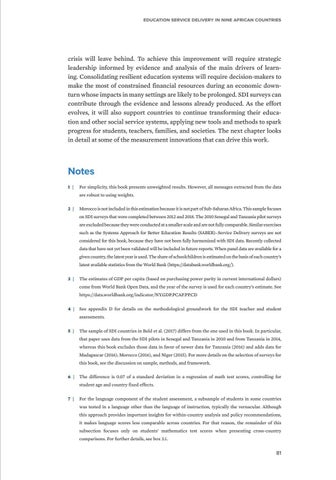Education service delivery in nine African countries
crisis will leave behind. To achieve this improvement will require strategic leadership informed by evidence and analysis of the main drivers of learning. Consolidating resilient education systems will require decision-makers to make the most of constrained financial resources during an economic downturn whose impacts in many settings are likely to be prolonged. SDI surveys can contribute through the evidence and lessons already produced. As the effort evolves, it will also support countries to continue transforming their education and other social service systems, applying new tools and methods to spark progress for students, teachers, families, and societies. The next chapter looks in detail at some of the measurement innovations that can drive this work.
Notes 1 | For simplicity, this book presents unweighted results. However, all messages extracted from the data are robust to using weights. 2 | Morocco is not included in this estimation because it is not part of Sub-Saharan Africa. This sample focuses on SDI surveys that were completed between 2012 and 2018. The 2010 Senegal and Tanzania pilot surveys are excluded because they were conducted at a smaller scale and are not fully comparable. Similar exercises such as the Systems Approach for Better Education Results (SABER)–Service Delivery surveys are not considered for this book, because they have not been fully harmonized with SDI data. Recently collected data that have not yet been validated will be included in future reports. When panel data are available for a given country, the latest year is used. The share of schoolchildren is estimated on the basis of each country’s latest available statistics from the World Bank (https://databank.worldbank.org/). 3 | The estimates of GDP per capita (based on purchasing power parity in current international dollars) come from World Bank Open Data, and the year of the survey is used for each country’s estimate. See https://data.worldbank.org/indicator/NY.GDP.PCAP.PP.CD 4 | See appendix D for details on the methodological groundwork for the SDI teacher and student assessments. 5 | The sample of SDI countries in Bold et al. (2017) differs from the one used in this book. In particular, that paper uses data from the SDI pilots in Senegal and Tanzania in 2010 and from Tanzania in 2014, whereas this book excludes those data in favor of newer data for Tanzania (2016) and adds data for Madagascar (2016), Morocco (2016), and Niger (2015). For more details on the selection of surveys for this book, see the discussion on sample, methods, and framework. 6 | The difference is 0.07 of a standard deviation in a regression of math test scores, controlling for student age and country fixed effects. 7 | For the language component of the student assessment, a subsample of students in some countries was tested in a language other than the language of instruction, typically the vernacular. Although this approach provides important insights for within-country analysis and policy recommendations, it makes language scores less comparable across countries. For that reason, the remainder of this subsection focuses only on students’ mathematics test scores when presenting cross-country comparisons. For further details, see box 3.1.
81


